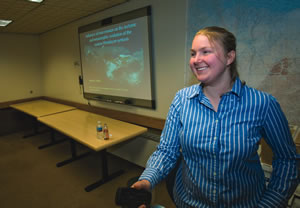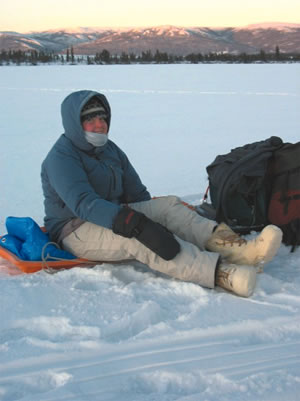UAF IPY postdoctoral fellows
Amanda Booth
by Jenn Wagaman, UAF Center for Research Services

UAF photo by Todd Paris.


Geology
Stanford University, CA
Postdoctoral Research
Quantitative estimates of climate variability derived from Alaska lake sediments
Mentor
Matthew Wooller
UAF, Institute of Marine Science
Hometown
Anchorage, Alaska
If you weren't a scientist, what would you be?
"I would be a mandolin player in a bluegrass band. My full name is Amanda Lynn, by the way."
On Amanda Booth's first career day she walked into a veterinarian's office and witnessed surgery on a rabbit. "I thought it was really cool, and it looked easy," Booth reflects. She was 10.
Although Booth thinks she was probably born a scientist, she feels the experience of working with the veterinarian is what sealed it for her in her mind. Science combined her love of nature with her drive to figure things out.
Since then, the Anchorage native has gone on to complete a doctoral degree at Stanford and most recently studied erosion and its influences on tectonics in Tibet. So why the University of Alaska Fairbanks?
"Because it's where all the action is," says Booth. "It's a good university with strong researchers and great facilities. It's the arctic university." Now, Booth's work in Fairbanks involves using isotopes from lake sediments to reconstruct the climate record for the Arctic over the last 10,000 years.
"The past is the key to the future," says Booth. "I'm trying to understand how the climate has changed in the recent past--well, recent on geological time scales. The age of the earth is 4.5 billion years so when we're talking tens of thousands of years, it's really a blink of an eye."
Using a special tool called a piston corer, Booth collects sediment samples from lake bottoms. Since sediments are continuously deposited over time, the deeper the samples are, the further back in time Booth can peer. The chemical composition of these samples provides Booth with information about the temperatures of the environment at the time the sample was deposited.
"I'm using minerals and organic matter that were preserved, or deposited in lakes," says Booth. "So the bugs and flies that you see flying around on the lake surface, they were hatched from larvae, and those remains fall to the bottom of the lake and are preserved. They're made of a material called chitin, and that has in it a ratio of isotopes that is reflective of the lake water that the organism lived in. And that ratio is dependent on temperature."
Booth's data will provide researchers with important insights into the fluctuations of climate in the past--insights that will hopefully provide clues about what is happening with our climate right now.
"To really fully understand the magnitude of temperature changes today, you have to put it in a context of what the Earth has experienced in the past," says Booth. "I think it's pretty amazing that people all over the world are working synergistically to go out and study polar climate together. It's exciting knowing that researchers like me are all looking at the same thing, and at the end of IPY we're going to be able to bring all of our results together."
Images courtesy Amanda Booth unless otherwise noted


